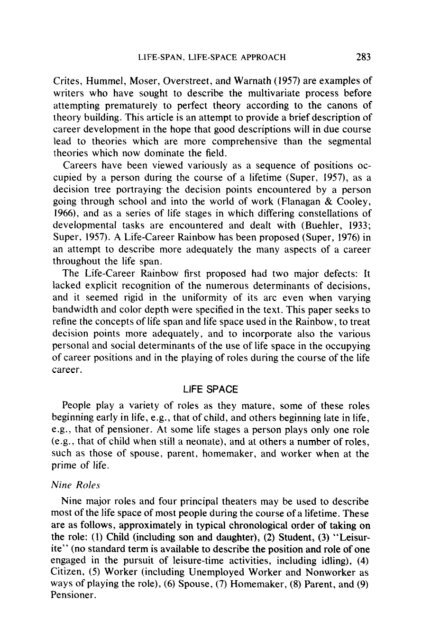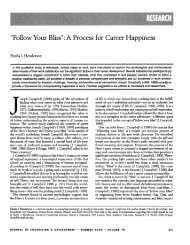A Life-Span, Life-Space Approach to Career Development
A Life-Span, Life-Space Approach to Career Development
A Life-Span, Life-Space Approach to Career Development
You also want an ePaper? Increase the reach of your titles
YUMPU automatically turns print PDFs into web optimized ePapers that Google loves.
LIFE-SPAN. LIFE-SPACE APPROACH 283<br />
Crites, Hummel, Moser, Overstreet, and Warnath (1957) are examples of<br />
writers who have sought <strong>to</strong> describe the multivariate process before<br />
attempting prematurely <strong>to</strong> perfect theory according <strong>to</strong> the canons of<br />
theory building. This article is an attempt <strong>to</strong> provide a brief description of<br />
career development in the hope that good descriptions will in due course<br />
lead <strong>to</strong> theories which are more comprehensive than the segmental<br />
theories which now dominate the field.<br />
<strong>Career</strong>s have been viewed variously as a sequence of positions oc-<br />
cupied by a person during the course of a lifetime (Super, 1957), as a<br />
decision tree portraying. the decision points encountered by a person<br />
going through school and in<strong>to</strong> the world of work (Flanagan & Cooley,<br />
1966), and as a series of life stages in which differing constellations of<br />
developmental tasks are encountered and dealt with (Buehler, 1933;<br />
Super, 1957). A <strong>Life</strong>-<strong>Career</strong> Rainbow has been proposed (Super, 1976) in<br />
an attempt <strong>to</strong> describe more adequately the many aspects of a career<br />
throughout the life span.<br />
The <strong>Life</strong>-<strong>Career</strong> Rainbow first proposed had two major defects: It<br />
lacked explicit recognition of the numerous determinants of decisions,<br />
and it seemed rigid in the uniformity of its arc even when varying<br />
bandwidth and color depth were specified in the text. This paper seeks <strong>to</strong><br />
refine the concepts of life span and life space used in the Rainbow, <strong>to</strong> treat<br />
decision points more adequately, and <strong>to</strong> incorporate also the various<br />
personal and social determinants of the use of life space in the occupying<br />
of career positions and in the playing of roles during the course of the life<br />
career.<br />
LIFE SPACE<br />
People play a variety of roles as they mature, some of these roles<br />
beginning early in life, e.g., that of child, and others beginning late in life,<br />
e.g., that of pensioner. At some life stages a person plays only one role<br />
(e.g., that of child when still a neonate), and at others a number of roles,<br />
such as those of spouse, parent, homemaker, and worker when at the<br />
prime of life.<br />
Nine Roles<br />
Nine major roles and four principal theaters may be used <strong>to</strong> describe<br />
most of the life space of most people during the course of a lifetime. These<br />
are as follows, approximately in typical chronological order of taking on<br />
the role: (1) Child (including son and daughter), (2) Student, (3) “Leisur-<br />
ite” (no standard term is available <strong>to</strong> describe the position and role of one<br />
engaged in the pursuit of leisure-time activities, including idling), (4)<br />
Citizen, (5) Worker (including Unemployed Worker and Nonworker as<br />
ways of playing the role), (6) Spouse, (7) Homemaker, (8) Parent, and (9)<br />
Pensioner.



